Qualitative Analysis of Gratitude in Children with Autism Spectrum Disorder
VerifiedAdded on 2023/04/10
|7
|1347
|308
AI Summary
This study aims to examine the qualitative analysis of gratitude as an important factor affecting children with Autism Spectrum Disorder (ASD). The paper explores the role of gratitude in the development of children with ASD and its impact on their overall well-being.
Contribute Materials
Your contribution can guide someone’s learning journey. Share your
documents today.

Running head: PSYCHOLOGY
Topic: PSYCHOLOGY
Name of the Student:
Name of the University:
Author’s Note:
Topic: PSYCHOLOGY
Name of the Student:
Name of the University:
Author’s Note:
Secure Best Marks with AI Grader
Need help grading? Try our AI Grader for instant feedback on your assignments.
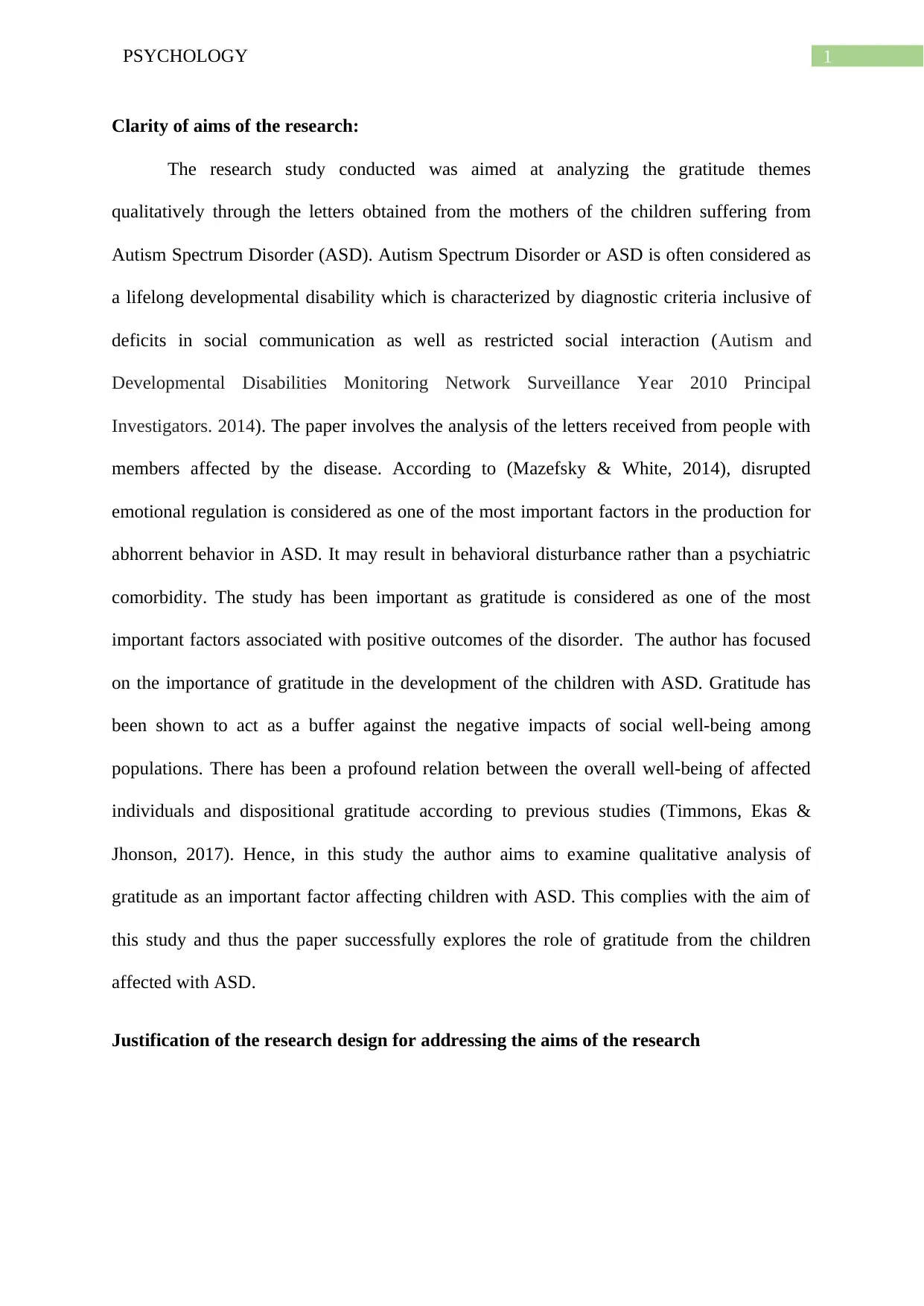
1PSYCHOLOGY
Clarity of aims of the research:
The research study conducted was aimed at analyzing the gratitude themes
qualitatively through the letters obtained from the mothers of the children suffering from
Autism Spectrum Disorder (ASD). Autism Spectrum Disorder or ASD is often considered as
a lifelong developmental disability which is characterized by diagnostic criteria inclusive of
deficits in social communication as well as restricted social interaction (Autism and
Developmental Disabilities Monitoring Network Surveillance Year 2010 Principal
Investigators. 2014). The paper involves the analysis of the letters received from people with
members affected by the disease. According to (Mazefsky & White, 2014), disrupted
emotional regulation is considered as one of the most important factors in the production for
abhorrent behavior in ASD. It may result in behavioral disturbance rather than a psychiatric
comorbidity. The study has been important as gratitude is considered as one of the most
important factors associated with positive outcomes of the disorder. The author has focused
on the importance of gratitude in the development of the children with ASD. Gratitude has
been shown to act as a buffer against the negative impacts of social well-being among
populations. There has been a profound relation between the overall well-being of affected
individuals and dispositional gratitude according to previous studies (Timmons, Ekas &
Jhonson, 2017). Hence, in this study the author aims to examine qualitative analysis of
gratitude as an important factor affecting children with ASD. This complies with the aim of
this study and thus the paper successfully explores the role of gratitude from the children
affected with ASD.
Justification of the research design for addressing the aims of the research
Clarity of aims of the research:
The research study conducted was aimed at analyzing the gratitude themes
qualitatively through the letters obtained from the mothers of the children suffering from
Autism Spectrum Disorder (ASD). Autism Spectrum Disorder or ASD is often considered as
a lifelong developmental disability which is characterized by diagnostic criteria inclusive of
deficits in social communication as well as restricted social interaction (Autism and
Developmental Disabilities Monitoring Network Surveillance Year 2010 Principal
Investigators. 2014). The paper involves the analysis of the letters received from people with
members affected by the disease. According to (Mazefsky & White, 2014), disrupted
emotional regulation is considered as one of the most important factors in the production for
abhorrent behavior in ASD. It may result in behavioral disturbance rather than a psychiatric
comorbidity. The study has been important as gratitude is considered as one of the most
important factors associated with positive outcomes of the disorder. The author has focused
on the importance of gratitude in the development of the children with ASD. Gratitude has
been shown to act as a buffer against the negative impacts of social well-being among
populations. There has been a profound relation between the overall well-being of affected
individuals and dispositional gratitude according to previous studies (Timmons, Ekas &
Jhonson, 2017). Hence, in this study the author aims to examine qualitative analysis of
gratitude as an important factor affecting children with ASD. This complies with the aim of
this study and thus the paper successfully explores the role of gratitude from the children
affected with ASD.
Justification of the research design for addressing the aims of the research
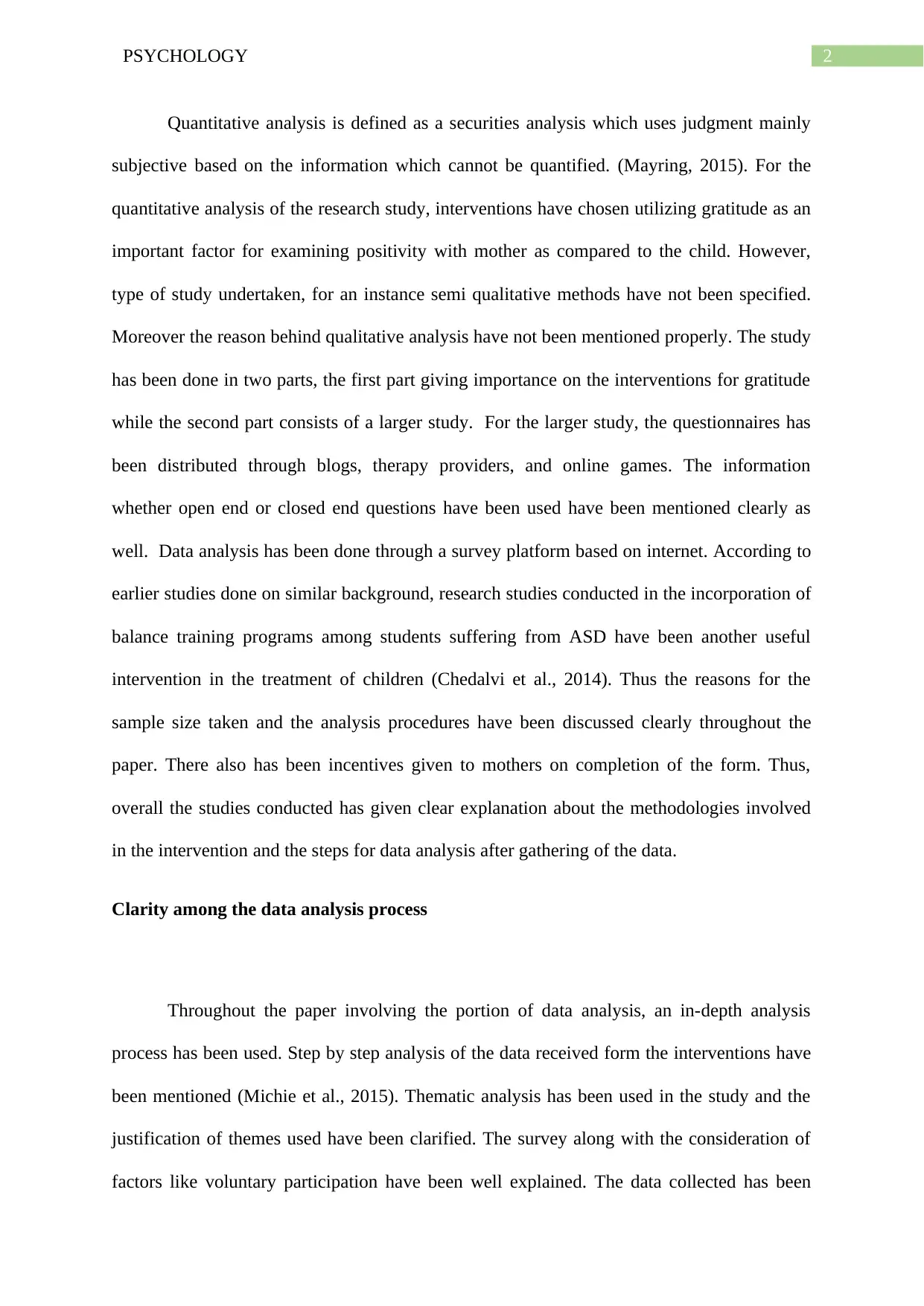
2PSYCHOLOGY
Quantitative analysis is defined as a securities analysis which uses judgment mainly
subjective based on the information which cannot be quantified. (Mayring, 2015). For the
quantitative analysis of the research study, interventions have chosen utilizing gratitude as an
important factor for examining positivity with mother as compared to the child. However,
type of study undertaken, for an instance semi qualitative methods have not been specified.
Moreover the reason behind qualitative analysis have not been mentioned properly. The study
has been done in two parts, the first part giving importance on the interventions for gratitude
while the second part consists of a larger study. For the larger study, the questionnaires has
been distributed through blogs, therapy providers, and online games. The information
whether open end or closed end questions have been used have been mentioned clearly as
well. Data analysis has been done through a survey platform based on internet. According to
earlier studies done on similar background, research studies conducted in the incorporation of
balance training programs among students suffering from ASD have been another useful
intervention in the treatment of children (Chedalvi et al., 2014). Thus the reasons for the
sample size taken and the analysis procedures have been discussed clearly throughout the
paper. There also has been incentives given to mothers on completion of the form. Thus,
overall the studies conducted has given clear explanation about the methodologies involved
in the intervention and the steps for data analysis after gathering of the data.
Clarity among the data analysis process
Throughout the paper involving the portion of data analysis, an in-depth analysis
process has been used. Step by step analysis of the data received form the interventions have
been mentioned (Michie et al., 2015). Thematic analysis has been used in the study and the
justification of themes used have been clarified. The survey along with the consideration of
factors like voluntary participation have been well explained. The data collected has been
Quantitative analysis is defined as a securities analysis which uses judgment mainly
subjective based on the information which cannot be quantified. (Mayring, 2015). For the
quantitative analysis of the research study, interventions have chosen utilizing gratitude as an
important factor for examining positivity with mother as compared to the child. However,
type of study undertaken, for an instance semi qualitative methods have not been specified.
Moreover the reason behind qualitative analysis have not been mentioned properly. The study
has been done in two parts, the first part giving importance on the interventions for gratitude
while the second part consists of a larger study. For the larger study, the questionnaires has
been distributed through blogs, therapy providers, and online games. The information
whether open end or closed end questions have been used have been mentioned clearly as
well. Data analysis has been done through a survey platform based on internet. According to
earlier studies done on similar background, research studies conducted in the incorporation of
balance training programs among students suffering from ASD have been another useful
intervention in the treatment of children (Chedalvi et al., 2014). Thus the reasons for the
sample size taken and the analysis procedures have been discussed clearly throughout the
paper. There also has been incentives given to mothers on completion of the form. Thus,
overall the studies conducted has given clear explanation about the methodologies involved
in the intervention and the steps for data analysis after gathering of the data.
Clarity among the data analysis process
Throughout the paper involving the portion of data analysis, an in-depth analysis
process has been used. Step by step analysis of the data received form the interventions have
been mentioned (Michie et al., 2015). Thematic analysis has been used in the study and the
justification of themes used have been clarified. The survey along with the consideration of
factors like voluntary participation have been well explained. The data collected has been
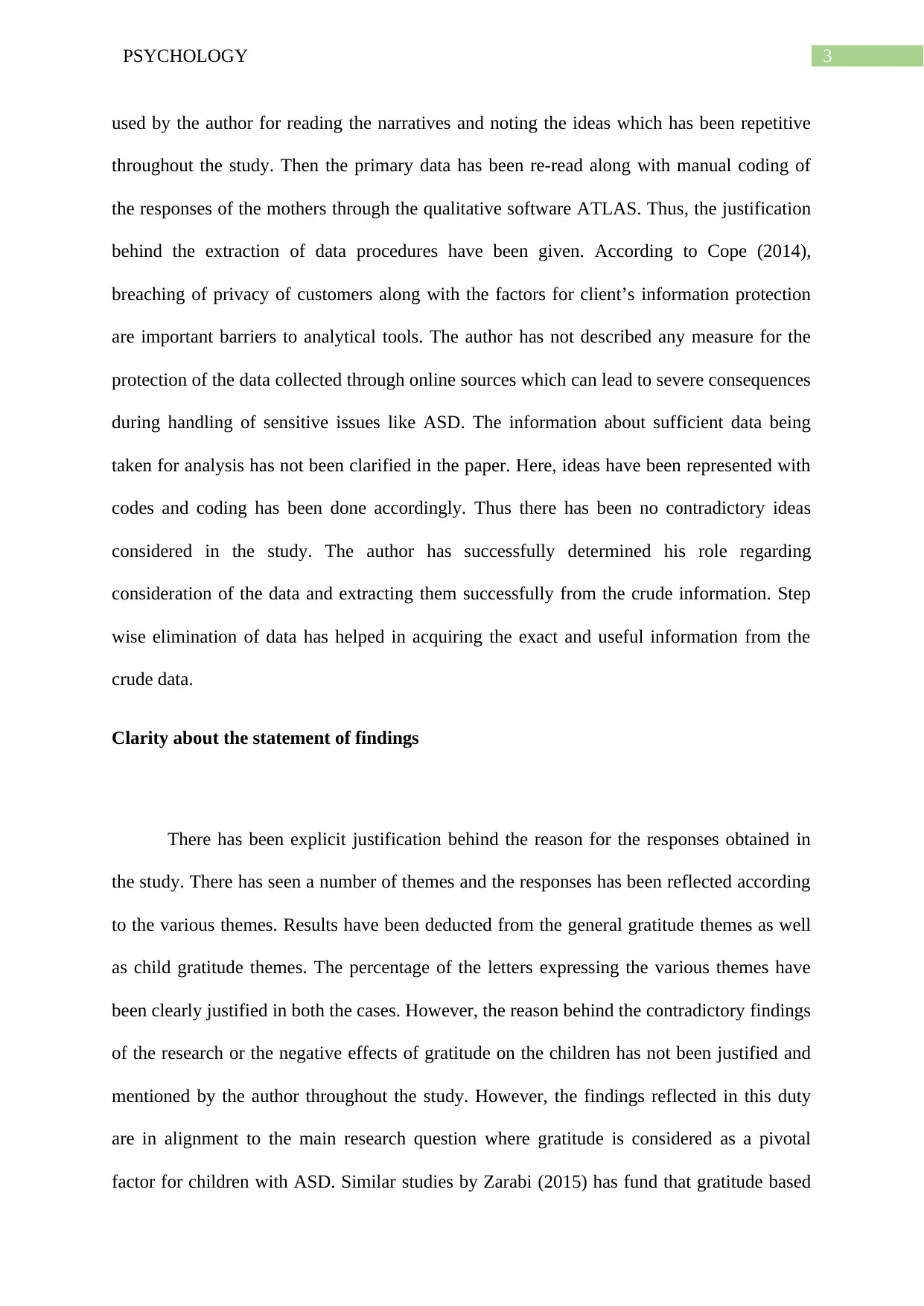
3PSYCHOLOGY
used by the author for reading the narratives and noting the ideas which has been repetitive
throughout the study. Then the primary data has been re-read along with manual coding of
the responses of the mothers through the qualitative software ATLAS. Thus, the justification
behind the extraction of data procedures have been given. According to Cope (2014),
breaching of privacy of customers along with the factors for client’s information protection
are important barriers to analytical tools. The author has not described any measure for the
protection of the data collected through online sources which can lead to severe consequences
during handling of sensitive issues like ASD. The information about sufficient data being
taken for analysis has not been clarified in the paper. Here, ideas have been represented with
codes and coding has been done accordingly. Thus there has been no contradictory ideas
considered in the study. The author has successfully determined his role regarding
consideration of the data and extracting them successfully from the crude information. Step
wise elimination of data has helped in acquiring the exact and useful information from the
crude data.
Clarity about the statement of findings
There has been explicit justification behind the reason for the responses obtained in
the study. There has seen a number of themes and the responses has been reflected according
to the various themes. Results have been deducted from the general gratitude themes as well
as child gratitude themes. The percentage of the letters expressing the various themes have
been clearly justified in both the cases. However, the reason behind the contradictory findings
of the research or the negative effects of gratitude on the children has not been justified and
mentioned by the author throughout the study. However, the findings reflected in this duty
are in alignment to the main research question where gratitude is considered as a pivotal
factor for children with ASD. Similar studies by Zarabi (2015) has fund that gratitude based
used by the author for reading the narratives and noting the ideas which has been repetitive
throughout the study. Then the primary data has been re-read along with manual coding of
the responses of the mothers through the qualitative software ATLAS. Thus, the justification
behind the extraction of data procedures have been given. According to Cope (2014),
breaching of privacy of customers along with the factors for client’s information protection
are important barriers to analytical tools. The author has not described any measure for the
protection of the data collected through online sources which can lead to severe consequences
during handling of sensitive issues like ASD. The information about sufficient data being
taken for analysis has not been clarified in the paper. Here, ideas have been represented with
codes and coding has been done accordingly. Thus there has been no contradictory ideas
considered in the study. The author has successfully determined his role regarding
consideration of the data and extracting them successfully from the crude information. Step
wise elimination of data has helped in acquiring the exact and useful information from the
crude data.
Clarity about the statement of findings
There has been explicit justification behind the reason for the responses obtained in
the study. There has seen a number of themes and the responses has been reflected according
to the various themes. Results have been deducted from the general gratitude themes as well
as child gratitude themes. The percentage of the letters expressing the various themes have
been clearly justified in both the cases. However, the reason behind the contradictory findings
of the research or the negative effects of gratitude on the children has not been justified and
mentioned by the author throughout the study. However, the findings reflected in this duty
are in alignment to the main research question where gratitude is considered as a pivotal
factor for children with ASD. Similar studies by Zarabi (2015) has fund that gratitude based
Secure Best Marks with AI Grader
Need help grading? Try our AI Grader for instant feedback on your assignments.
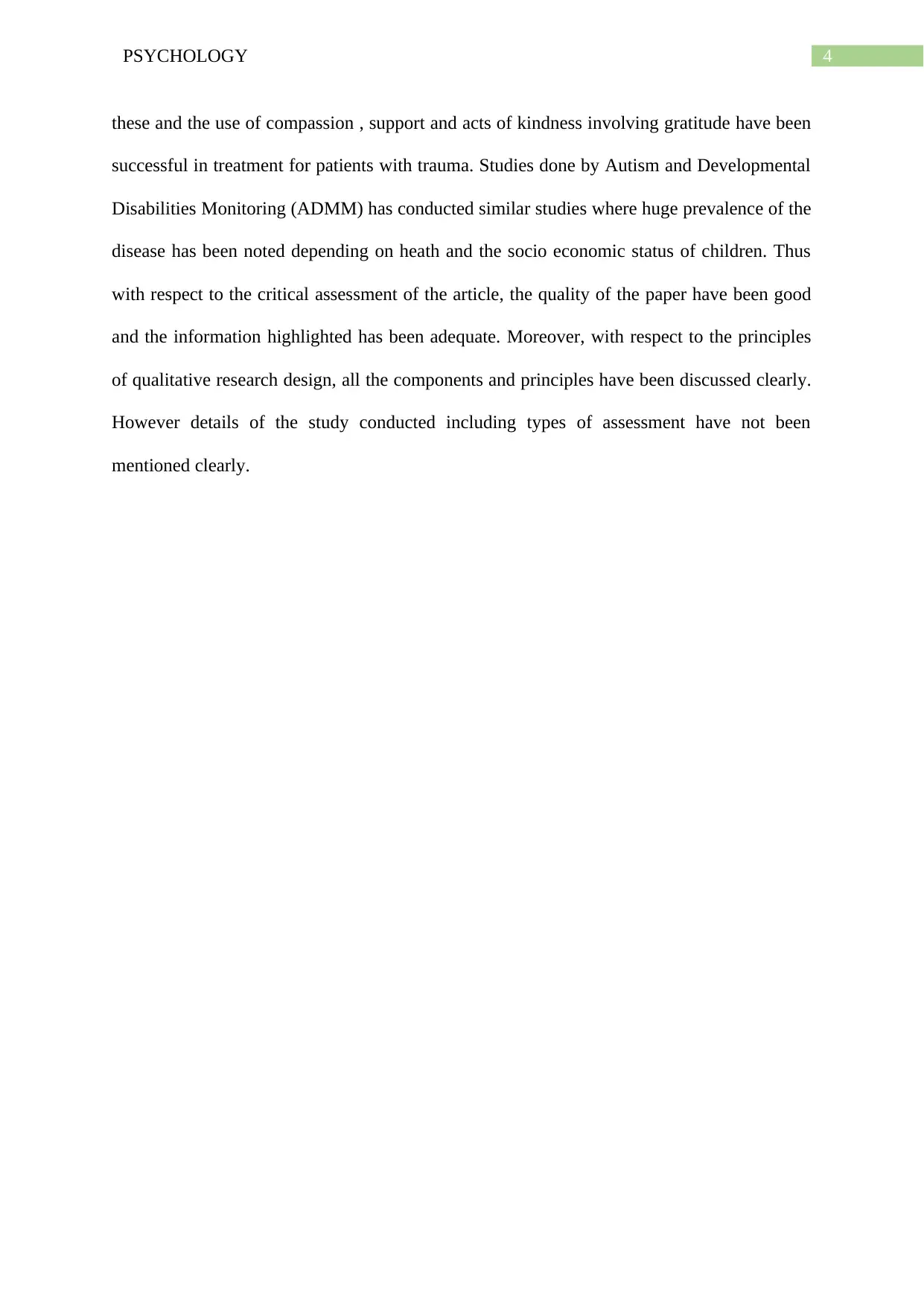
4PSYCHOLOGY
these and the use of compassion , support and acts of kindness involving gratitude have been
successful in treatment for patients with trauma. Studies done by Autism and Developmental
Disabilities Monitoring (ADMM) has conducted similar studies where huge prevalence of the
disease has been noted depending on heath and the socio economic status of children. Thus
with respect to the critical assessment of the article, the quality of the paper have been good
and the information highlighted has been adequate. Moreover, with respect to the principles
of qualitative research design, all the components and principles have been discussed clearly.
However details of the study conducted including types of assessment have not been
mentioned clearly.
these and the use of compassion , support and acts of kindness involving gratitude have been
successful in treatment for patients with trauma. Studies done by Autism and Developmental
Disabilities Monitoring (ADMM) has conducted similar studies where huge prevalence of the
disease has been noted depending on heath and the socio economic status of children. Thus
with respect to the critical assessment of the article, the quality of the paper have been good
and the information highlighted has been adequate. Moreover, with respect to the principles
of qualitative research design, all the components and principles have been discussed clearly.
However details of the study conducted including types of assessment have not been
mentioned clearly.
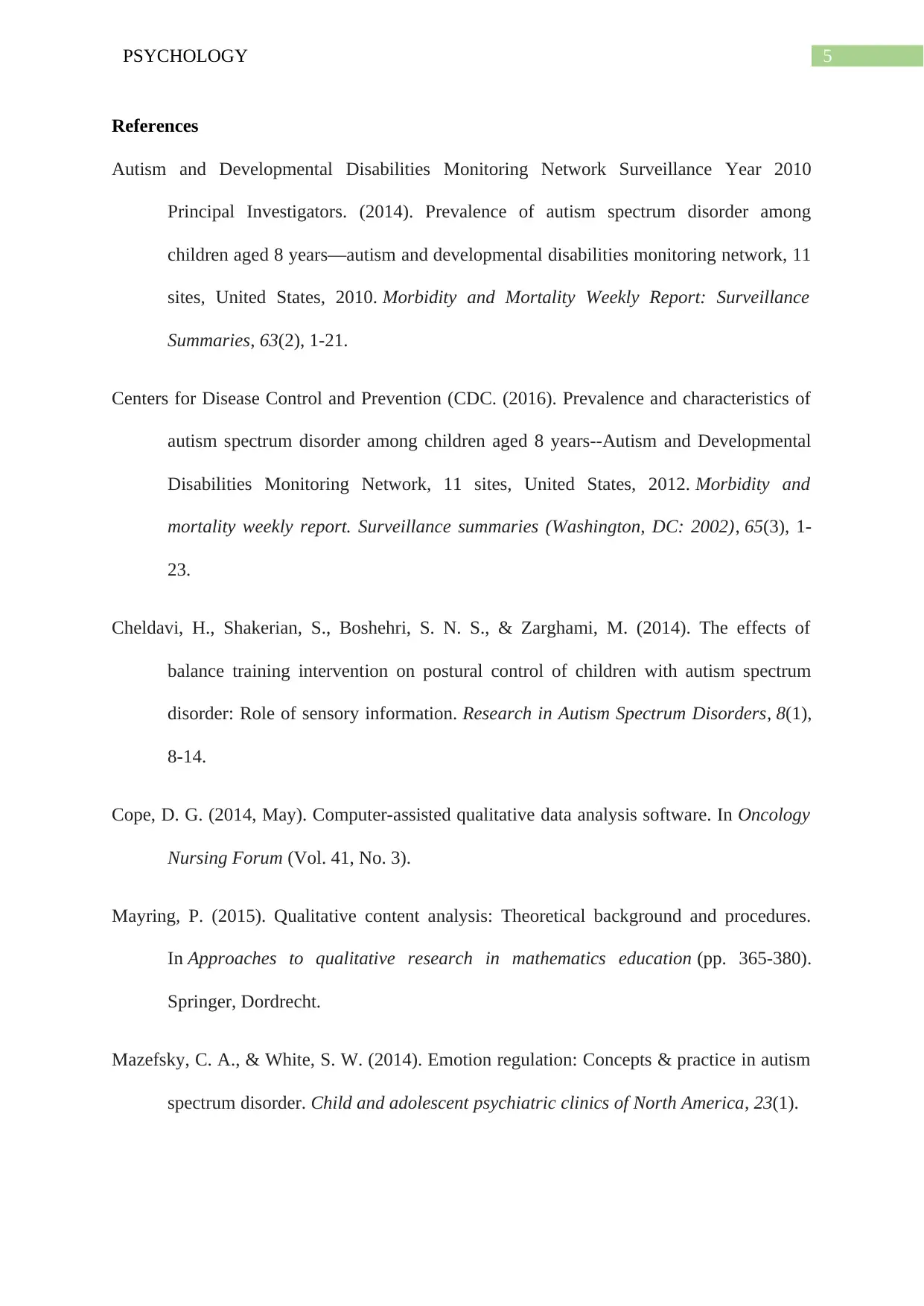
5PSYCHOLOGY
References
Autism and Developmental Disabilities Monitoring Network Surveillance Year 2010
Principal Investigators. (2014). Prevalence of autism spectrum disorder among
children aged 8 years—autism and developmental disabilities monitoring network, 11
sites, United States, 2010. Morbidity and Mortality Weekly Report: Surveillance
Summaries, 63(2), 1-21.
Centers for Disease Control and Prevention (CDC. (2016). Prevalence and characteristics of
autism spectrum disorder among children aged 8 years--Autism and Developmental
Disabilities Monitoring Network, 11 sites, United States, 2012. Morbidity and
mortality weekly report. Surveillance summaries (Washington, DC: 2002), 65(3), 1-
23.
Cheldavi, H., Shakerian, S., Boshehri, S. N. S., & Zarghami, M. (2014). The effects of
balance training intervention on postural control of children with autism spectrum
disorder: Role of sensory information. Research in Autism Spectrum Disorders, 8(1),
8-14.
Cope, D. G. (2014, May). Computer-assisted qualitative data analysis software. In Oncology
Nursing Forum (Vol. 41, No. 3).
Mayring, P. (2015). Qualitative content analysis: Theoretical background and procedures.
In Approaches to qualitative research in mathematics education (pp. 365-380).
Springer, Dordrecht.
Mazefsky, C. A., & White, S. W. (2014). Emotion regulation: Concepts & practice in autism
spectrum disorder. Child and adolescent psychiatric clinics of North America, 23(1).
References
Autism and Developmental Disabilities Monitoring Network Surveillance Year 2010
Principal Investigators. (2014). Prevalence of autism spectrum disorder among
children aged 8 years—autism and developmental disabilities monitoring network, 11
sites, United States, 2010. Morbidity and Mortality Weekly Report: Surveillance
Summaries, 63(2), 1-21.
Centers for Disease Control and Prevention (CDC. (2016). Prevalence and characteristics of
autism spectrum disorder among children aged 8 years--Autism and Developmental
Disabilities Monitoring Network, 11 sites, United States, 2012. Morbidity and
mortality weekly report. Surveillance summaries (Washington, DC: 2002), 65(3), 1-
23.
Cheldavi, H., Shakerian, S., Boshehri, S. N. S., & Zarghami, M. (2014). The effects of
balance training intervention on postural control of children with autism spectrum
disorder: Role of sensory information. Research in Autism Spectrum Disorders, 8(1),
8-14.
Cope, D. G. (2014, May). Computer-assisted qualitative data analysis software. In Oncology
Nursing Forum (Vol. 41, No. 3).
Mayring, P. (2015). Qualitative content analysis: Theoretical background and procedures.
In Approaches to qualitative research in mathematics education (pp. 365-380).
Springer, Dordrecht.
Mazefsky, C. A., & White, S. W. (2014). Emotion regulation: Concepts & practice in autism
spectrum disorder. Child and adolescent psychiatric clinics of North America, 23(1).
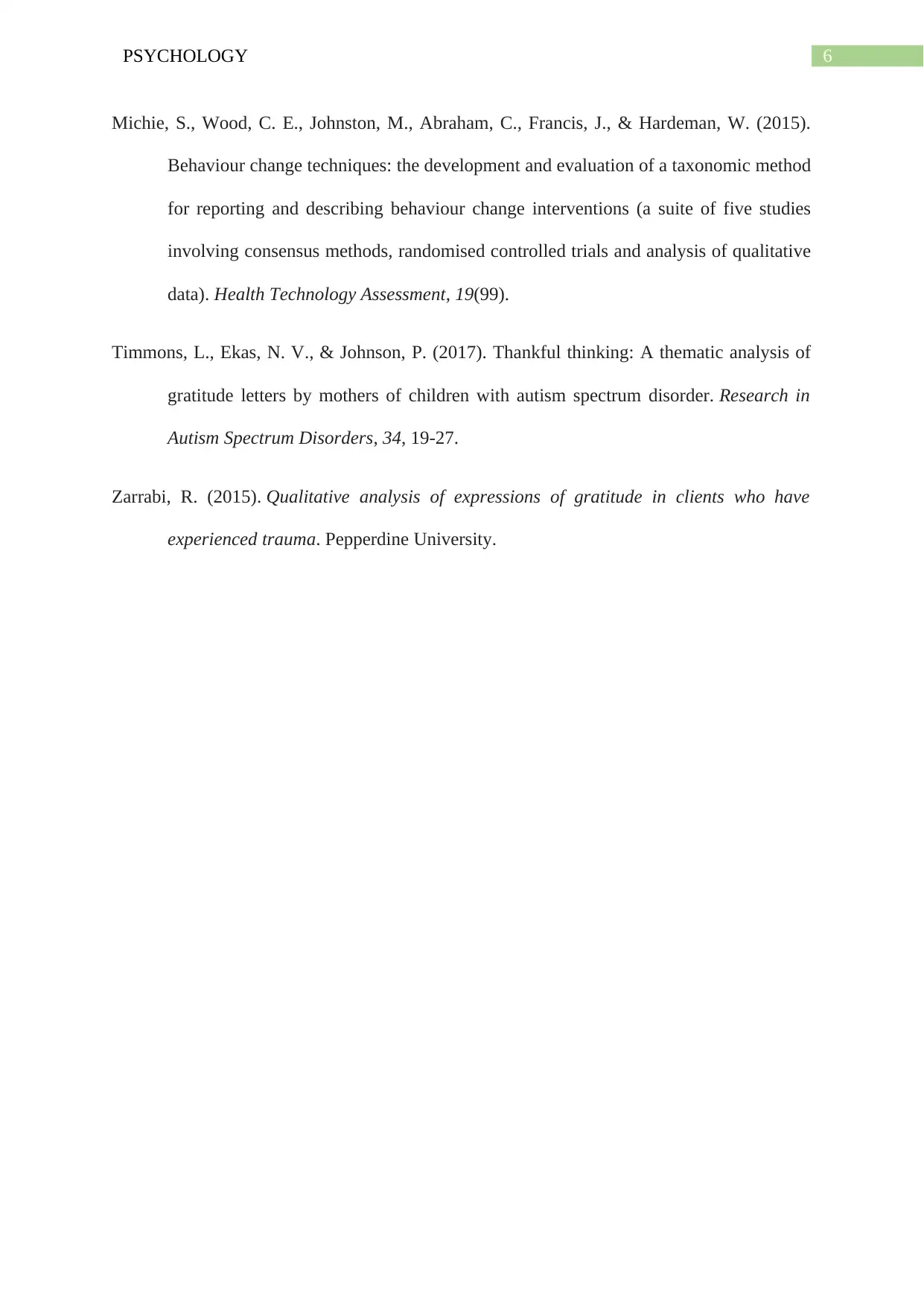
6PSYCHOLOGY
Michie, S., Wood, C. E., Johnston, M., Abraham, C., Francis, J., & Hardeman, W. (2015).
Behaviour change techniques: the development and evaluation of a taxonomic method
for reporting and describing behaviour change interventions (a suite of five studies
involving consensus methods, randomised controlled trials and analysis of qualitative
data). Health Technology Assessment, 19(99).
Timmons, L., Ekas, N. V., & Johnson, P. (2017). Thankful thinking: A thematic analysis of
gratitude letters by mothers of children with autism spectrum disorder. Research in
Autism Spectrum Disorders, 34, 19-27.
Zarrabi, R. (2015). Qualitative analysis of expressions of gratitude in clients who have
experienced trauma. Pepperdine University.
Michie, S., Wood, C. E., Johnston, M., Abraham, C., Francis, J., & Hardeman, W. (2015).
Behaviour change techniques: the development and evaluation of a taxonomic method
for reporting and describing behaviour change interventions (a suite of five studies
involving consensus methods, randomised controlled trials and analysis of qualitative
data). Health Technology Assessment, 19(99).
Timmons, L., Ekas, N. V., & Johnson, P. (2017). Thankful thinking: A thematic analysis of
gratitude letters by mothers of children with autism spectrum disorder. Research in
Autism Spectrum Disorders, 34, 19-27.
Zarrabi, R. (2015). Qualitative analysis of expressions of gratitude in clients who have
experienced trauma. Pepperdine University.
1 out of 7
Related Documents
Your All-in-One AI-Powered Toolkit for Academic Success.
+13062052269
info@desklib.com
Available 24*7 on WhatsApp / Email
![[object Object]](/_next/static/media/star-bottom.7253800d.svg)
Unlock your academic potential
© 2024 | Zucol Services PVT LTD | All rights reserved.





